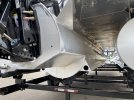Potomacbassin’
Well-Known Member
My initial thought is that you have reached the potential of your particular hull/boat/motor combo.
That's where my head is as well. You can only reduce wetted surface so much by changing thrust angle before it induces proposing, and OP has hit it.
OP you're seeing additional speed as the boat is cycling to the top of the oscillation where drag is at an artificially low state. Conversely, when the boat is at the bottom of the porpoise there is a high amount of artificially induced drag and you drop in speed. So unless you can sustain that lower drag amount - less weight, more HP to get more of the hull out of the water, additional modification to achieve better planing of the tubes, etc. - hitting 53 IMO will be tough.
Maybe raising engine height or a better prop (less stern lifting design? more rake?) can get another 1-2mph? Lower the bimini?
My trick is to run with an outgoing tide with the wind to my back and 1/4 tank of gas!
Last edited:


